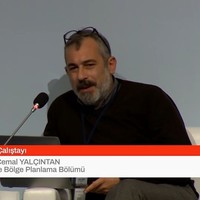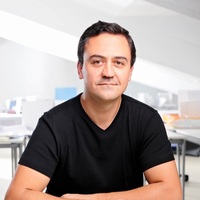Papers by José Fernández-Cavia
Revista panamericana de comunicación, Apr 25, 2024
Place branding and public diplomacy, May 21, 2024

catalaEn aquesta recerca es realitza un mapa general de les tendencies en perfils i competencies ... more catalaEn aquesta recerca es realitza un mapa general de les tendencies en perfils i competencies professionals del sector de la publicitat, i s'identifica quins son nous i quins es mantenen pero adopten un especial protagonisme en un context marcat per la irrupcio de les noves tecnologies i la crisi economica i social. S'ha dut a terme una revisio de la produccio cientifica recent i s'ha entrevistat un total de dinou professionals publicitaris. Els resultats mostren dues tendencies en el sector: cap a l'extrema especialitzacio en l'ambit tecnologic o cap a la interdisciplinarietat. Els entrevistats assumeixen que la constant actualitzacio dels seus coneixements en aquest ambit es un assumpte totalment personal. Davant d'aquesta situacio, l'educacio superior a Espanya es troba amb el repte d'incorporar amb celeritat els coneixements necessaris per a crear professionals capacos de bregar en un entorn complex i eminentment digital. EnglishThis research i...

Information and Communication Technologies (ICTs) have had a significant impact on both the trave... more Information and Communication Technologies (ICTs) have had a significant impact on both the travel and tourism experience and industry. In particular, Destination Marketing Organizations (DMOs) have found ICT a powerful ally to harmonize and coordinate the activities of local stakeholders, as well as to reach travellers. The aim of this research is to analyse destination brand communication strategies, especially those applied to online communication (official websites, social media and mobile applications). Data was collected from Spanish destinations – regions, provinces and cities via an online survey addressed to destination brand and communication managers. Results show that destination brand communication is not fully standardised or professionalised yet; online tools (websites, social media and mobile applications) are used tactically and not strategically and the usefulness of social media and official websites is clearly more appreciated by DMO managers than the usefulness ...

La Web se ha convertido en el principal instrumento de búsqueda de información por parte de los t... more La Web se ha convertido en el principal instrumento de búsqueda de información por parte de los turistas. Por este motivo, los portales turísticos de los destinos deben resultar atractivos y comunicar de una manera adecuada y eficaz su imagen de marca. No existe, sin embargo, una metodología de evaluación de la calidad y eficacia comunicativa de los sitios web de destino que sea científicamente sólida y universalmente aceptada. El desarrollo de esa metodología es una de las tareas que nos hemos propuesto en el marco del proyecto de investigación "Nuevas estrategias de publicidad y promoción de las marcas turísticas españolas en la web" (CSO2008-02627), financiado por el Ministerio de Ciencia e Innovación del Gobierno de España. Metodología: El equipo del proyecto ha elaborado una plantilla de análisis interdisciplinaria y omnicomprensiva que combina algunos análisis automatizados con otros de tipo cualitativo y cuantitativo. La plantilla contempla un total de doce temáticas y 154 indicadores, que se han elaborado a partir de la aportación de destacados expertos en cada una de las áreas de trabajo. En este artículo se expone la metodología de análisis elaborada y se explican las aplicaciones posibles. Resultados: El proyecto ha elaborado una metodología de evaluación que permite optimizar los sitios web de las marcas de destino, apoyando, así, el trabajo de los gestores públicos de los destinos turísticos. [EN] Introduction: The World Wide Web has become the primary instrument used by tourists in order to search for information. As a result, tourism websites pertaining to destinations need to be appealing and must convey their brand image in an appropriate, effective manner. However, there is

En aquesta recerca es realitza un mapa general de les tendències en perfils i competències profes... more En aquesta recerca es realitza un mapa general de les tendències en perfils i competències professionals del sector de la publicitat, i s’identifica quins són nous i quins es mantenen però adopten un especial protagonisme en un context marcat per la irrupció de les noves tecnologies i la crisi econòmica i social. S’ha dut a terme una revisió de la producció científica recent i s’ha entrevistat un total de dinou professionals publicitaris. Els resultats mostren dues tendències en el sector: cap a l’extrema especialització en l’àmbit tecnològic o cap a la interdisciplinarietat. Els entrevistats assumeixen que la constant actualització dels seus coneixements en aquest àmbit és un assumpte totalment personal. Davant d’aquesta situació, l’educació superior a Espanya es troba amb el repte d’incorporar amb celeritat els coneixements necessaris per a crear professionals capaços de bregar en un entorn complex i eminentment digital.This research involves the development of a general map of th...

Hipertext.net, 2015
After six years investigating this topic thanks to two research projects funded by the Spanish go... more After six years investigating this topic thanks to two research projects funded by the Spanish government, I am able to present some conclusions I hope are of interest for other communication researchers. However, before I begin, I would like to introduce three key ideas to understand the context of this object of study. Firstly, the economic importance of tourism has to be reminded. This is an activity which generates about ten percent of the world's GDP (WTTC, 2014), and is an essential source of income for many countries, either developed, emerging or developing. Besides, it is a highly globalized sector, thanks to the evolution of transportation infrastructures, universal access to information and new consumption habits, which have favored that leisure travel is commonly contemplated by increasing segments of the world's population. In this scenario, destinations compete between each other to attract travelers and wealth to their territories, and distances are becoming increasingly irrelevant in this competition. Secondly, it is important to highlight that tourism professionals are the ones in charge of daily destination management, whereas the academic field attracts researchers from disciplines such as geography, economy, sociology or market research. Both in the professional and academic spheres, contributions based on a communication focus are still scarce, and probably insufficient (Huertas, 2014).
The Routledge Companion to Media and Tourism, 2020
Aquest llibre analitza les responsabilitats institucionals en els processos de comunicacio de ris... more Aquest llibre analitza les responsabilitats institucionals en els processos de comunicacio de risc dels poligons petroquimics a l’area de Tarragona. Com a tematica complexa i estrategica, implica tant una oportunitat per a les industries com un repte per a les politiques publiques i llurs bones practiques. Aquesta recerca comunicativa innovadora permet repensar-nos com a societat democratica tot obrint noves vies de reflexio i eines d’intervencio.

BiD: textos universitaris de biblioteconomia i documentaci�, 2014
Qualitat dels llocs web turístics oficials de les comunitats autònomes espanyoles Resum Object iu... more Qualitat dels llocs web turístics oficials de les comunitats autònomes espanyoles Resum Object ius: analitzar la qualitat dels llocs web turístics oficials de les comunitats autònomes espanyoles. Metodologia: metodologia pròpia, elaborada pel projecte d'investigació CODET UR, basada en una plantilla d'anàlisi que pr eveu dotze paràmetres i un total de 127 indicadors. La combinació d'indicadors i par àmetres permet calcular un índex de qualitat web (IQW) per a cada lloc avaluat, un índex específic per a cada paràmetr e i també identificar aspectes sobresortints i àrees de millora en cadascun dels portals turístics. Result ats: la qualitat general dels por tals turístics oficials de les comunitats autònomes espanyoles se situa just per sobre d'un nivell mitjà, amb un IQW global de 0,51. La puntuació més elevada l'obté el lloc web de tur isme de Galícia, amb un 0,66, i la puntuació més baixa, el d'Extr emadura, amb un IQW de 0,33. Els paràmetres que presenten la mitjana més elevada són els referents a Usabilitat i accessibilitat (0,75), Posicionament (0,73) i Arquitectura de la informació (0,69), aspectes considerats "tècnics" en l'estudi, mentre que els paràmetr es que obtenen la puntuació mitjana més baixa són els referents a Comunicació mòbil (0,27), Interactivitat (0,28) i Comercialització (0,29), aspectes considerants "relacionals" i "persuasius" en l'estudi.

Communication & Society, 1970
It is common to introduce special issues on place branding with the observation that the last 25 ... more It is common to introduce special issues on place branding with the observation that the last 25 years or so have seen an impressive rise in its significance as an academic field and its popularity as a practice. Academics in several disciplines are focusing their attention on the ways in which branding can be applied to places, reflecting the complex, crossdisciplinary nature of the field. The valuable work of a number of scholars in recent years has advanced the theoretical background of the discipline. Furthermore, the application of branding strategies to a variety of places has greatly contributed to the popularization and professionalization of the field, something also verified by the founding of the International Place Branding Association. However, if place branding is no longer an emerging field of study, it has not yet established itself as a mature discipline. This is, at least partly, a result of the lack of consensus as to its theoretical foundations, its 'proper' practical application or, indeed, its effectiveness. Skinner's earlier assessment of the confusion evident in the field (Skinner, 2008) is still accepted as valid (e.g. Kavaratzis et al., 2015). Braun (2012) finds an explanation for this confusion-in addition to the relative youth of the field-in the fact that there is no single accepted definition of brands and branding within the marketing/branding mainstream. Furthermore, places as branded entities present particular challenges and increased complexity (e.g. Morgan et al., 2011). One of the prevailing qualities of place branding is that it critically affects people's lives as residents and citizens. At the same time, one of its most problematic features is that the image and reputation of places depend heavily on factors that are complex and often impossible to control. To further complicate things, another fascinating characteristic of place branding is its crossdisciplinary nature, which makes it necessary to cross-fertilise approaches. In the study of place branding, theoretical underpinnings from many disciplines like economics, urban planning, geography, sociology, tourism, marketing, politics and so forth have all played an important role. This is, of course, particularly the case for the discipline of communication, whose links to place branding are indeed very strong. In a sense, it could be argued that branding is in essence a form of communication. This is why this special issue on place branding in a communication journal becomes timely and relevant. This special issue deals with place branding from a communication perspective and sets out to provide a starting point for a deeper examination of the relationship between these two fields. To do that, it is useful to go back to the basics of this relationship, which is what this introduction attempts. 1. Branding and Communication Anholt (2005) asserts that there are three ways in which the terms brand and branding are used. First, there is a popular but inaccurate way that Special issue Place Branding

, ассистент кафедры уголовного процесса и криминалистики, Самарский национальный исследовательски... more , ассистент кафедры уголовного процесса и криминалистики, Самарский национальный исследовательский университет имени академика С. П. Королева, 443086, Российская Федерация, г. Самара, Московское шоссе, 34. Автор и соавтор 7 научных публикаций. Область научных интересов: уголовный процесс, меры безопасности в отношении участников уголовного судопроизводства, предварительное расследование. АННОТАЦИЯ В данной статье рассматриваются случаи ограничения конституционного права на тайну телефонных переговоров и иных сообщений, допускаемое в целях обеспечения безопасности свидетелей в ходе производства по уголовному делу. Частным случаем оправданного ограничения указанного права является применение контроля и записи переговоров свидетелей по основанию, предусмотренному ч. 2 ст. 186 УПК РФ. Автором проводится разграничение между контролем и записью телефонных и иных переговоров, используемых как следственное действие и в качестве меры безопасности по критериям цели, наличия фактических и формальных оснований. Автор сравнивает контроль и запись переговоров и прослушивание телефонных переговоров как способы получения сведений об осуществлении посткриминального воздействия на свидетелей и делает вывод об идентичности указанных действий с точки зрения их правовой сущности. В статье очерчен круг проблем применения контроля и записи переговоров как меры безопасности, выявлены несоответствия между нормами уголовно-процессуального законодательства. В статье представлены обширный анализ практики применения контроля и записи переговоров, в том числе данные опросов практических работников и примеры из судебной практики, обзор и сопоставление мнений ведущих ученых, а также авторские позиции и предложения о внесении поправок в действующий уголовно-процессуальный закон в целях устранения обнаруженных противоречий, приведения норм к единообразию и повышения эффективности обеспечения безопасности свидетелей по уголовным делам. Ключевые слова: свидетель, меры безопасности, безопасность личности в уголовном судопроизводстве, право на тайну переписки, телефонных переговоров, почтовых, телеграфных и иных сообщений, неприкосновенность частной жизни, контроль и запись переговоров, следственные действия, предварительное расследование, охрана прав и свобод человека и гражданина, ограничение конституционных прав. Цитирование. Свечникова Е. И. Ограничение конституционного права граждан на тайну телефонных переговоров и иных сообщений, допускаемое в целях обеспечения безопасности свидетелей при расследовании уголовных дел // Юридический вестник Самарского университета. 2018. Т. 4. № 3. С. 120-126.
City marketing tries to position cities in the mind of the public, although the process of creati... more City marketing tries to position cities in the mind of the public, although the process of creating and communicating city brands is still at an early stage of its development. One of the main tools for the communication of these brands is now the World Wide Web. This chapter describes the results of two combined studies (qualitative and quantitative) that analyzes a sample of official city Web sites. The results show that official Web sites of cities give much attention to ease of navigation, but interactivity is much less implemented, especially between users. Furthermore, some lack of attention to the communication aspects of city brands can also be found. Finally, the chapter submits a number of improvement proposals.











Uploads
Papers by José Fernández-Cavia